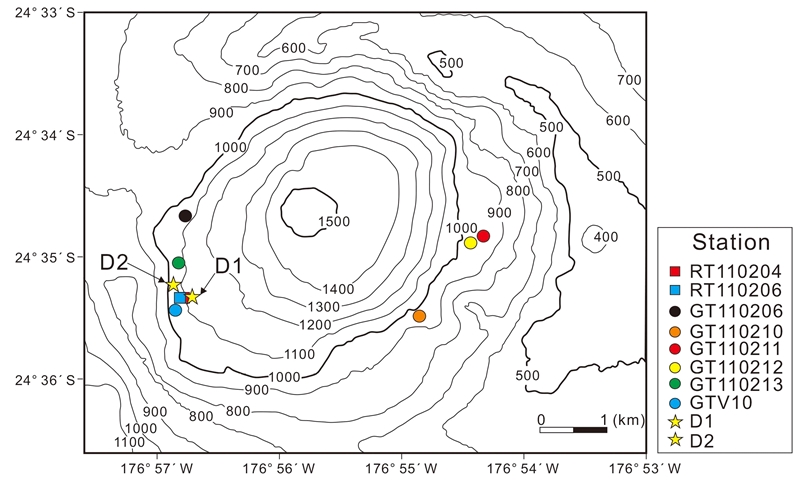
남서태평양 통가열도 TA25해저화산의 열수작용에 의한 해저퇴적물 특성
초록
남서태평양 통가열도에 위치하는 TA25 해저화산에서 열수작용의 영향을 밝히기 위해서 무인잠수정(remotely operated vehicle; ROV)과 비디오 카메라가 장착된 그랩(TV-guided grab sampler; GTV)을 사용하여 시료를 채취하였다. TA25 해저화산에서 채취된 세립질 표층퇴적물은 전자현미분석기(EPMA)의 후방산란전자영상(BSEI)과 에너지분산형 분광분석기(EDS)를 사용하여 퇴적물의 형태, 조직, 성분 등을 분석하였다. 조립질 부석들은 외곽부에 암갈색의 물질로 피복되어 있는데, X-선 형광분석기(XRF)와 유도결합 플라즈마 분광분석기(ICP-OES)를 사용하여 부석의 내부 유백색 부분과 외부 암갈색 부분의 주원소와 금속원소 조성을 분석하였다. 표층퇴적물에서는 열수기원 황산염광물과 황화광물에 속하는 중정석(barite), 황철석(pyrite), 망간수산화물(manganese hydroxides), 섬아연석(sphalerite), 황동석(chalcopyrite) 입자들이 관찰되었다. 관모(crested) 형태의 중정석은 열수기원 용존 Ba과 해수의 황산염이 결합하여 침전된 것으로 해석되며, 비정질(amorphous) 망간수산화물, 교질상(colloform) 황철석, 섬아연석, 황동석 파편들은 일차적인 열수작용으로 형성된 이후에 이동되어 퇴적된 것으로 분석되었다. 일부 표층퇴적물에서는 저서생물에 의해서 생성된 타원형의 배설물이 관찰되는데, 이것은 열수분출구 근처의 저서생물 군집 발달을 지시한다. 조립질 부석은 낮은 칼륨함량을 갖는 데사이트질 마그마(low-K dacitic magma) 성분으로, 부석의 외곽부는 열수기원의 Ba, Sr, Pb, Nb, V, Co, Ni, Cu, Zn, Mo 금속원소와 철산화물과 망간산화물이 부화된 암갈색 물질로 피복되어 있다.
Abstract
To investigate influence of hydrothermal activities in TA25 submarine volcano, Tonga Arc, SW Pacific Ocean, we collected marine sediment samples using TV-guided grab sampler (GTV) and remotely operated vehicle (ROV). To determine morphological, textural, and chemical characteristics of fine-grained surface sediments, we employed Backscattered Electron Imaging (BSEI) and Energy Dispersive Spectrometer (EDS) attached to an Electron Probe Micro Analyzer (EPMA). We then analyzed major and metal elements of outer dark brown and inner milky white portions of coarse-grained pumice samples using X-ray Fluorescence Spectrometer (XRF) and Inductively Coupled Plasma-Optical Emission Spectroscopy (ICP-OES). The results showed that the fine-grained surface sediments were composed mainly of barite and manganese hydroxides with pyrite, sphalerite, and chalcopyrite, representing hydrothermal sulfide and sulfate minerals. We interpreted that the crested barites were precipitated from dissolved Ba, indicating a strong influence of hydrothermal fluids and seawater sulfate. In addition, the presence of amorphous manganese hydroxides, colloform pyrite, sphalerite, and chalcopyrite suggest transportation after the primary precipitation having a hydrothermal origin. The observed elliptical fecal pellets formed by benthic organisms suggest existence of hydrothermal vent-related chemosynthetic communities at the sampling site. Finally, our analyses on coarse-grained pumice samples confirm the influence of hydrothermal fluids as reflected by the low-K dacitic magma origin in the inner parts, and significantly high Fe2O3 and MnO contents and enrichments of Ba, Sr, Pb, Nb, V, Co, Ni, Cu, Zn, and Mo elements in the outer pars.
Keywords:
Tonga, TA25 submarine volcano, marine sediments, pumice, hydrothermal activities키워드:
통가, TA25 해저화산, 해저퇴적물, 부석, 열수작용1. 서 론
해저 열수분출구(submarine hydrothermal vents)는 수렴형 또는 확산형 판경계(convergent or divergent plate boundaries)에 발달된 해저화산에서 주로 보고되었으며, 심부로부터 공급된 열수(hydrothermal fluids)에 의해서 해저면에 침니(chimney) 또는 마운드(mound) 형태로 열수광상이 형성되거나, 열수분출구 주변에 독립적인 해저생태계도 발달된다(Paropkari et al., 2010; Park et al., 2015; Wilckens et al., 2018; Dong et al., 2019; Menini and Dover, 2019; Watanabe et al., 2019; Eom et al., 2020; Fang and Wang, 2021; Georgieva et al., 2021; Keith et al., 2021). 열수는 대부분 해저화산의 균열대와 단층을 따라서 상승하는데(Omosanya et al., 2018; Keith et al., 2021), 용존 상태의 금속 성분과 황화수소와 이산화탄소 등의 가스와 뜨거운 해수로 구성되어 있다(Cronan and Hodkinson, 1997; Chavagnac et al., 2018; Hung et al., 2018; Gartman et al., 2019; Stensland et al., 2019; Eom et al., 2020; Wan et al., 2021). 남서태평양에 위치하는 통가-케르마데크 해구(Tonga-Kermadec Trench)에서의 섭입작용에 의해서 형성된 통가열도(Tonga Arc)에는 다수의 화산들이 분포하며, 일부 해저화산에서는 침니와 마운드 형태의 열수분출구가 다수 발견되었다(그림 1; Cronan and Hodkinson, 1997). 우리나라는 통가열도 해저열수광상의 분포 및 환경에 대한 연구의 일환으로 2009년부터 한국해양과학기술원 주관으로 탐사를 활발히 실시하였으며, 해저화산, 열수광상, 해양생태계 등의 다양한 분야 연구가 진행되었다(Cho et al., 2012; KORDI, 2012; Kim et al., 2013; Um et al., 2013; Lee, S. et al., 2015; Kim et al., 2016; Choi et al., 2018; Lee, W.-K. et al., 2021b). 통가열도 TA25(또는 Volcano 18S, Kim et al., 2016)와 TA26(또는 Volcano 19, Kim et al., 2016) 해저화산에서는 현재도 활동중인 열수분출구가 확인되었고(Kim et al., 2016), 이곳에서 채취된 해저퇴적물의 금속원소, 희토류원소, 점토광물의 함량 차이에 의해서 열수변질 증거를 밝힐 수 있었다(그림 1; Cho et al., 2012; Um et al., 2013). 현재 활동중인 열수분출구로부터 200 m 이내에 설치된 퇴적물 트랩(sediment trap)의 침전물을 분석하였는데, 상부 대륙지각의 평균 금속함량보다 높은 Fe, Mn, Cu, Zn 금속함량이 열수작용에 의한 것으로 해석되었다(Kim et al., 2016). 열수기원 수은(Hg) 함량은 해저퇴적물 뿐만 아니라 열수분출구 주변에 서식하는 연체동물(mollusks)에서도 높게 나타났다(Lee et al., 2015). 통가열도에서 채취된 해저퇴적물의 금속원소, 희토류원소, 점토광물 분석으로 열수작용에 의한 영향이 밝혀졌지만, 열수기원의 황화광물(sulfide minerals)과 황산염광물(sulfate mineral)의 형태와 분포 특성은 밝혀지지 않았다. 또한 열수분출구가 위치하는 지역에 발달된 화산쇄설성 퇴적층(volcaniclastic deposits)에 대한 열수작용 영향도 연구되지 않았다. 이번 연구에서는 통가열도 TA25 해저화산에서 열수작용에 의한 세립질 표층퇴적물과 조립질 부석 시료의 퇴적학적, 광물학적, 지화학적 특성을 밝힐 것이다.
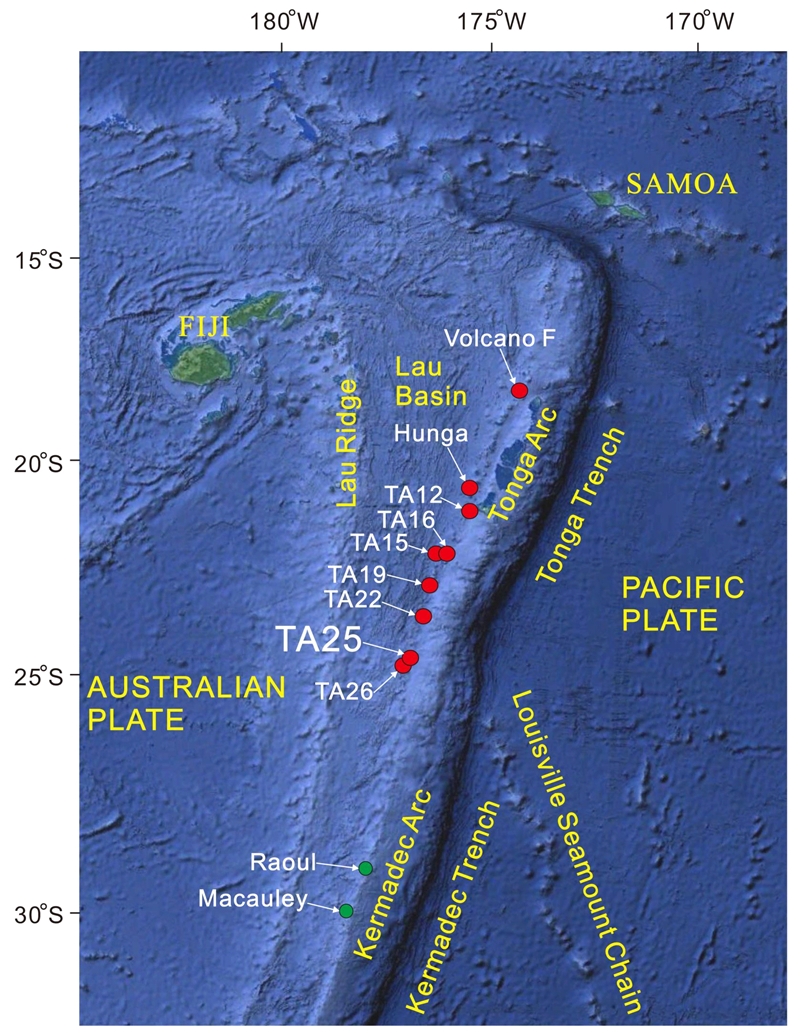
Location map showing TA25 submarine volcano on the Tonga Arc. Other arc volcanoes TA12, TA15, TA16, TA19, TA22, TA26, Hunga, and Volcano F (red circles) are located at the eastern margin of the Lau Back-arc Basin as a result of subduction at the Tonga Trench (Um et al., 2013; Choi et al., 2018; Brandl et al., 2020; Myeong et al., 2020; Brenna et al., 2022). Also shown are Macauley and Raoul islands (green circles) formed at the southwestern margin due to subduction at the Kermadec Trench (Worthington et al., 1999; Smith et al., 2003).
2. 연구지역 및 연구방법
2.1 연구지역
남서태평양 통가-케르마데크 해구에서 태평양판이 호주판으로 섭입하여 통가-케르마데크 열도가 형성되었다(Worthington et al., 1999; Clift et al., 2001; Smith and Price, 2006). 통가-케르마데크 열도는 태평양판에 발달된 루이빌 해저산맥(Louisville Seamount Chain)을 기준으로 북동측은 통가 해구의 섭입과 남서측은 케르마데크 해구의 섭입 작용에 의한 영향을 받는다(그림 1; Myeong et al., 2020). 통가열도 해저화산의 마그마 성분은 결핍된 맨틀(depleted mantle wedge), 원양성 퇴적물을 포함하는 부분용융, 변질 해양지각의 섭입 동안의 탈수작용에 의해 생성된 용액 등으로 혼합된 것으로 해석되었다(Myeong et al., 2020). 케르마데크열도 해저화산의 마그마 성분은 통가열도 해저화산(TA15, TA16, TA19)에 비하여 루이빌 해저산맥에 쌓인 원양성 퇴적물 성분이 높게 나타났다(Myeong et al., 2020). 통가열도 TA12 (Volcano #1, Kim et al., 2013) 해저화산에서는 환상형 단층에 의한 칼데라의 발달과 칼데라 내부에서의 화산쇄설성 퇴적층과 재동된 암석편층이 최대 두께 2 km 정도 쌓여 있다(Hekinian et al., 2008, Kim et al., 2013). 통가열도에서는 2019년 8월 수심 약 35 m에 위치하는 Volcano F 해저화산에서 다량의 데사이트질 또는 조면암질 부석(dacitic or rhyolitic pumice)이 분출되어, 해수면에 뜬 상태로 이동되는 것이 인공위성 영상으로 확인되었다(Brandl et al., 2020). 통가열도 Hunga 화산에서는 2022년 1월에 대규모 화산분화가 일어나며 쓰나미(tsunami)가 발생되었는데, 이번 화산분화에 의해서 2014년 12월부터 2015년 1월 사이의 안산암질 마그마(andesitic magma) 화산분화에 의하여 Hunga Ha’apai 섬과 Hunga Tonga 섬 사이에 형성되었던 응회구(tuff cone)의 대부분이 파괴되었다(그림 1; Brenna et al., 2022). 이번 연구지역인 통가열도 TA25 해저화산의 마그마 성분은 보고되지 않았으나, 활동성 또는 비활동성 열수분출구들이 다수 보고되었다(Daesslé et al., 2000; Kim et al., 2016). TA25 해저화산(또는 Volcano 18S)은 직경 약 6.5 km의 칼데라가 발달하는데, 칼데라 서측이 동측에 비하여 수심이 약 300 m 이상 깊게 나타난다(그림 2; Kim et al., 2016). 다수의 열수분출구가 확인된 지역에 조사정점들이 위치하는데, 칼데라 서측 활동성 열수분출구에서 측정된 최고 온도는 약 231℃ 정도이고, 칼데라 동측의 활동성 열수분출구로부터 관측된 블랙 스모커(black smoker)의 최고 온도는 약 263℃ 정도이다(Kim et al., 2016).
2.2 연구방법
통가열도 TA25 해저화산의 해저퇴적물 시료들은 2009년과 2012년에 R/V Sonne에서 무인잠수정(remotely operated vehicle; ROV)과 비디오 카메라가 장착된 그랩(TV-guided grab sampler; GTV)을 사용하여 채취되었다(KORDI, 2012). TA25 해저화산의 서측에 위치하는 RT110204, RT110206, GT110213 조사정점에서는 조립질 부석들을 채취하였다(그림 2; 표 1). TA25 해저화산의 서측에 위치하는 GT110206, GT110213, GTV10 조사정점과 동측에 위치하는 GT110210, GT110211, GT110212 조사정점에서는 세립질 표층퇴적물을 채취하였다(그림 2; 표 1). TA25 해저화산 서측 수심 1,000~1,100 m에 위치하는 D1과 D1 조사정점에서는 무인잠수정에 장착된 고화질 비디오 카메라를 사용하여 해저면 영상을 획득하였다(그림 3).

Photographs showing volcaniclastic deposits (VD) and rock debris deposits (RD) on the seafloor from the western caldera of TA25 submarine volcano. (a) D1 station, (b) D2 station. fMs: fine-grained marine sediments. See Figure 2 for location.
6개 조사 정점에서 채취된 6점의 세립질 표층퇴적물은(110206, 110213, 10, 110210, 110211, 110212) 실험실에서 체질로 4 φ 이상의 입자를 분리하였고, 과학용 오븐에서 60℃ 조건으로 하루 동안 건조하였다(표 1). 건조된 입자들은 레진을 사용하여 연마편을 제작하였으며, 한국기초과학지원연구원 전주센터 전자현미분석기(electron probe micro analyzer; EPMA)의 후방산란전자영상(back-scattered electron image; BSEI)장치를 사용하여 입자 형태와 조직을 분석하였고, 에너지분산형 분광분석기(energy dispersive spectrometer; EDS)를 사용하여 성분을 측정하였다.
3개 조사 정점의 해저면에서 6점의 조립질 부석(04-06, 04-08, 04-11, 06-04, 13-1, 13-2)을 채취하였다(그림 2; 표 1). 부석은 실험실에서 종방향으로 절단하여 외곽부의 암갈색으로 피복된 부분과 내부의 유백색 부분을 채취하여 분말화 하였다. 그림 4에서는 4점의 조립질 부석(04-8, 04-11, 06-04, 13-2)에 대한 시료 채취부분이 표시되어 있다. 암갈색 외곽부와 유백색 내부의 분말 시료는 한국지질자원연구원이 보유한 X-선 형광분석기(X-ray fluorescence spectrometer; XRF)를 사용하여 SiO2, TiO2, Al2O3, Fe2O3, MnO, MgO, CaO, Na2O, K2O, P2O5의 주원소 조성을 분석하였다. 또한 이 시료들은 한국지질자원연구원이 보유한 유도결합 플라즈마 분광분석기(inductively coupled plasma-optical emission spectroscopy; ICP-OES)를 사용하여, Ba, Rb, Sr, Pb, Zr, Nb, Sc, V, Co, Ni, Cu, Zn, Mo 금속원소를 분석하였다.
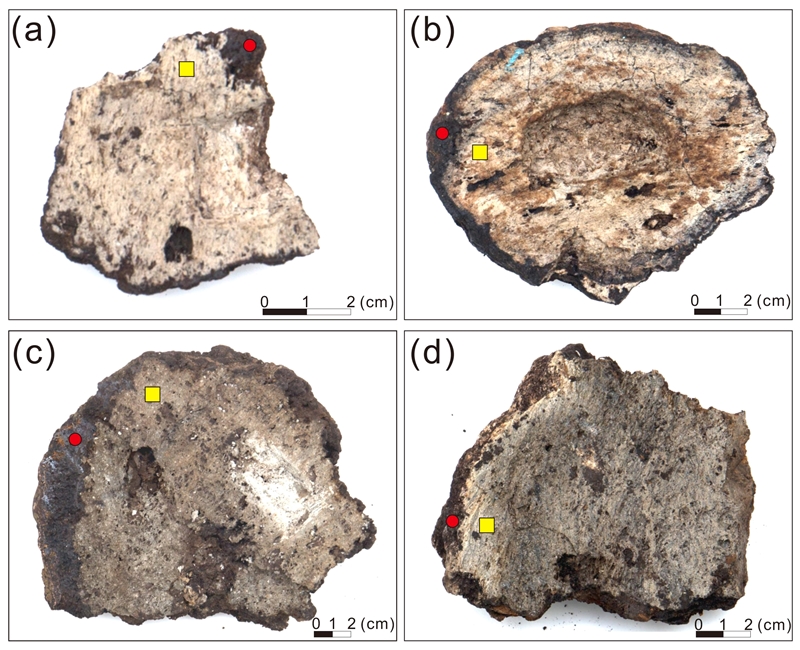
Photographs showing the selected pumice samples from the western caldera of TA25 submarine volcano. (a) 06-04 sample from the RT110206 station, (b) 13-2 sample from the GT110213 station, (c) 04-8, and (d) 04-11 samples from the RT110204 station. The red circles (outer) and yellow squares (inner) represent the portions of pumice samples for XRF and ICP-OES analyses.
3. 결 과
3.1 조립질 부석의 기원마그마 및 피복 물질 분석
TA25 해저화산 칼데라 서부(그림 2; D1, D2 정점, 수심 1,000~1,100 m)에서는 층상의 화산쇄설성 퇴적층(volcaniclastic deposits; VD)이 발달하며, 재동된 암석편(rock debris deposits; RD)들이 해저면에 노출되어 있다(그림 3). D1 정점에서는 해저면에 화산쇄설성 퇴적층이 노출되어 있고 세립질 해저퇴적물이 얇게 덮여 있으나, 상대적으로 수심이 깊은 D2 정점에서는 재동된 암석편층과 다소 두껍게 덮여 있는 해저퇴적물이 관찰된다(그림 3). 인근 RT110204, RT11020, GT110213 정점에서 채취된 조립질 부석(직경 7~18 cm)들은 외곽부에 두께 1 cm 이내의 암갈색 물질이 피복하고 있다(그림 4). 부석 내부 유백색 부분의 SiO2 함량은 63.76~69.48 wt%이고 Na2O와 K2O 함량은 각각 4.23~5.19 wt%와 0.50 ~0.57 wt% 이다(표 2). 이 부석들은 총알칼리와 실리카 함량(total alkali/silica; TAS) 도표에서 데사이트질 마그마(dacitic magma) 영역에 표시되며, 낮은 칼륨 영역에 표시된다(그림 5). 유백색 부분의 Fe2O3, MnO, MgO 함량은 각각 3.85~4.28 wt%, 0.14~0.48 wt%, 0.72~0.96 wt%이다(표 2). 부석 외곽부 암갈색 부분의 MnO 함량은 1.26~43.94 wt% 범위로 유백색 부분과 비교하여 항상 높으며, 최대 300 배 이상 높게 나타난다(그림 6b; 표 2). 암갈색 부분의 Fe2O3와 MgO 함량도 각각 3.92~14.65 wt%와 1.24~3.80 wt% 범위로 유백색 부분과 비교하여 각각 최대 3.8배와 5.3배 높게 나타난다(그림 6a; 표 2). 이에 반해 암갈색 부분의 SiO2, Al2O3, Na2O 함량은 유백색 부분에 비하여 낮게 나타난다(표 2). K2O와 P2O5 함량은 부석의 암갈색 부분이 유백색 부분과 비교하여 다소 높게 나타난다(표 2). 암갈색 부분의 TiO2와 CaO 함량은 유백색 부분에 비하여 다소 낮거나 일부 시료에서는 다소 높게 나타난다(표 2).

Major element contents (wt%) of the selected pumice from the TA25 submarine volcano measured by XRF. LOI=loss on ignition. Inner milky white (P) and outer dark brown (O) portions of the selected pumice for XRF analysis.

(a) Total alkali versus silica and (b) Potassium versus silica diagrams showing magma compositions of samples from the RT110204 station (samples 04-06, 04-08, and 04-11), the RT110206 station (sample 06-04), and the GT110214 station (samples 13-1 and 13-2) from the western caldera of TA25 submarine volcano. Geochemical data from TA15, TA16, and TA19 submarine volcanoes (Myeong et al., 2020), volcano F (Brandl et al., 2020), and Macauley (M) island (Smith et al., 2003) were also plotted (enclosed dashed lines with gray shading). (P): inner milky white part of pumice.
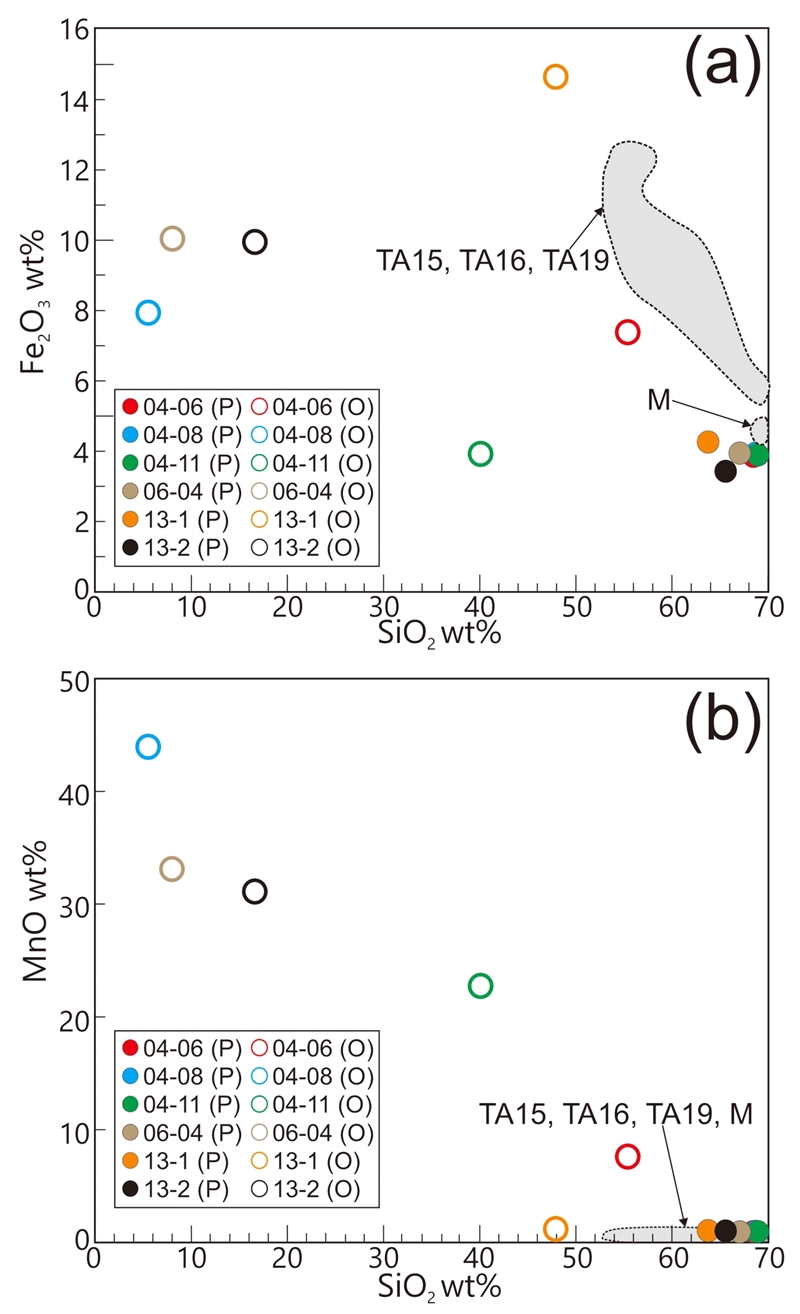
Comparison of major elements between inner milky white (P) and outer dark brown (O) portions of the selected pumice samples from the western caldera of TA25 submarine volcano. (a) Fe2O3 versus SiO2 plot, (b) MnO versus SiO2 plot. Geochemical data from TA15, TA16, and TA19 submarine volcanoes (Myeong et al., 2020) and Macauley (M) island (Smith et al., 2003) are shown as well.
부석의 외곽 암갈색 부분과 내부 유백색 부분의 금속원소의 함량도 큰 차이를 보인다. 암갈색 부분의 Ba (1,350~7,660 ppm), Sr (789~6,180 ppm), Pb (170~7,950 ppm), Nb (33.0~93.2 ppm), V (242~692 ppm,), Ni (29.5~576 ppm), Cu (79.2~29,300 ppm), Mo (78.8~1,990 ppm) 함량은 유백색 부분의 Ba, Sr, Pb, Nb, V, Ni, Cu, Mo 함량에 비하여 아주 높게 나타난다(표 3). 암갈색 부분의 Sc 함량은 유백색 부분에 비하여 다소 낮게 나타난다(표 3). 부석 외곽 암갈색 부분의 Rb와 Zr 함량은 유백색 부분에 비하여 시료에 따라 금속원소 함량 변화가 불규칙하게 나타난다(표 3). Ba/Zr과 Sr/Zr 함량비는 암갈색 부분이 유백색 부분과 비교하여 각각 최대 28배와 최대 33배 이상 높게 나타난다(그림 7). Cu와 Ni 함량은 일부 시료에서 부석의 외곽부에 피복된 암갈색 부분이 내부의 유백색 부분보다 수 십 또는 수 백배 높게 나타난다(표 3).

Metal element contents (ppm) of the selected pumice from TA25 submarine volcano measured by ICP-OES. The P (inner milky white) and O (outer dark brown) represent the portions of the selected pumice for ICP-OES analysis.
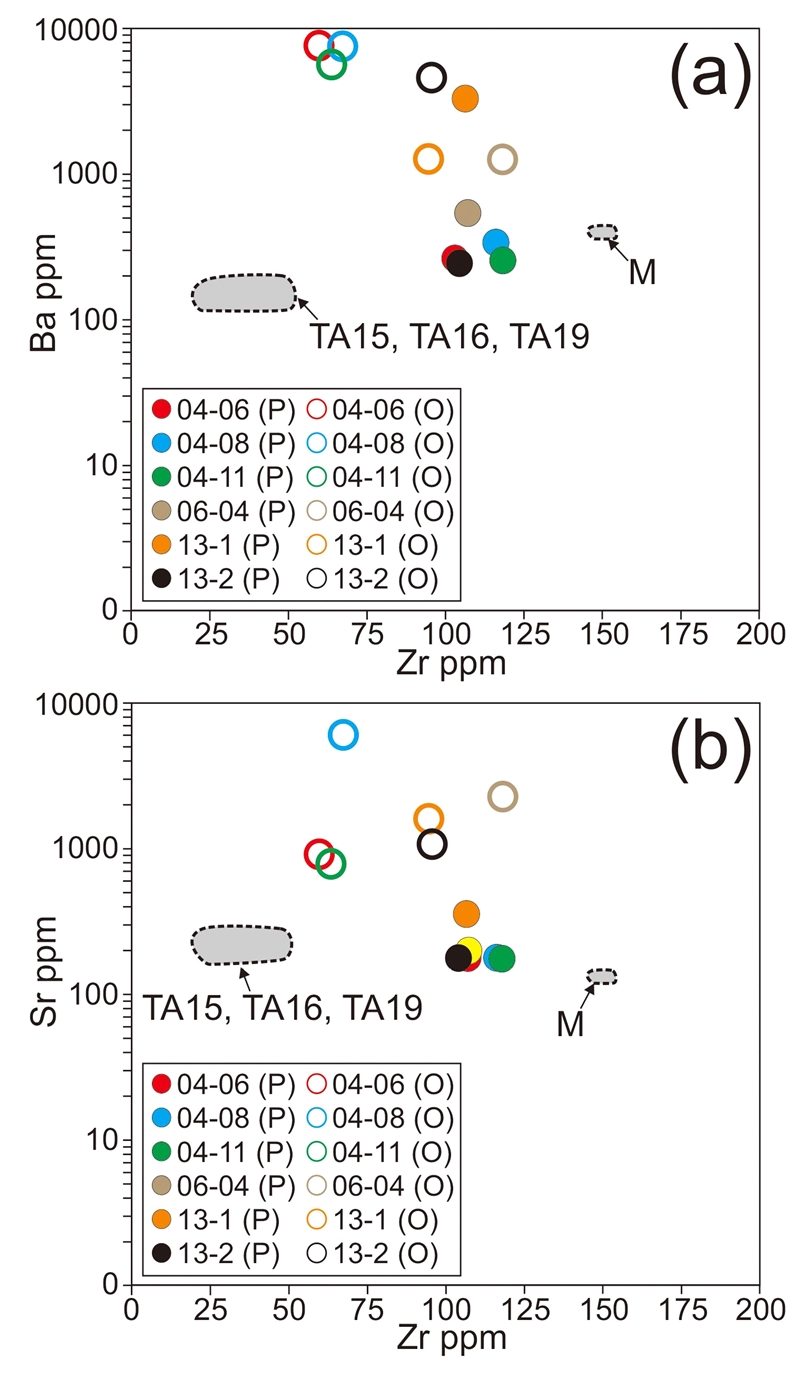
Comparison of metal elements between inner milky white (P) and outer dark brown (O) portions of the selected pumice samples from the western caldera of TA25 submarine volcano. (a) Ba versus Zr plot, (b) Sr versus Zr plot. Plots also show geochemical data from TA15, TA16, and TA19 submarine volcanoes (Myeong et al., 2020) and Macauley (M) island (Smith et al., 2003).
3.2 세립질 표층퇴적물의 조직 및 성분
TA25 해저화산 칼데라 서부 GTV20 정점(수심 1,037 m)의 표층퇴적물은 200~500 µm 크기의 각진(angular) 비정질 망간수산화물(amorphous man-ganese hydroxide) 입자, 부석 입자에 침전된 중정석(barite), 200~500 µm 크기의 광물들로 구성되어 있다(그림 8a). 관모 형태(crested)의 중정석은 부석의 한쪽 면에만 침전되어 있으며, 중정석이 침전된 면의 일부 부석 기공(vesicle) 내에서도 중정석이 관찰된다(그림 8b). 비정질 망간수산화물과 중정석의 구성 성분은 에너지분산형 분광분석기를 사용하여 확인되었다(그림 8c, 8d). 해저화산 칼데라 동부의 GT110210 정점(수심 985 m)에서는 길이 약 1.5 mm의 섬아연석(sphalerite) 입자와 약 400 µm 크기의 망간수산화물 입자, 중정석이 발견되었다(그림 9a). 섬아연석과 망간수산화물 입자들은 각진 형태이며, 중정석은 약 100 µm 크기의 관모 형태로 개별 입자 또는 군집을 이룬다(그림 9b). 섬아연석 입자와 중정석의 구성 성분은 에너지분산형 분광분석기를 사용하여 확인되었다(그림 9c, 9d). TA25 해저화산 칼데라 동부 수심 945 m의 GT110211 정점 표층퇴적물에서는 20~60 µm 크기의 교질상 황철석 집합체(colloform pyrite aggregates)가 발견되었다(그림 10a). 교질상 황철석에서는 포도상(framboidal) 입자의 흔적이 미약하게 나타난다(그림 10a). 이 표층퇴적물에서는 100~300 µm 크기의 타원형 배설물(fecal pellet)들이 다수 관찰된다(그림 11a). 배설물 내에는 수~수 십 µm 크기의 입자들이 뭉쳐 있으며, 외곽에 미세립 입자의 얇은 벽이 형성되어 있다(그림 11b). TA25 해저화산 칼데라 동부 GT110212 정점(수심 981 m)에서 채취된 표층퇴적물에서는 관모 형태의 중정석 집합체와 황동석(chalcopyrite) 입자가 관찰되었다(그림 10b). 이 표층퇴적물은 각진 망간수산화물 입자와 약 500 µm 크기의 관모 형태 중정석, 100~400 µm 크기의 부석 입자와 미고생물(biogenic components) 들이 분포한다(그림 11c). 해저화산 수심 1,084 m의 서측 칼데라에서 채취된 GT110206 정점의 표층퇴적물은 대부분 50~400 µm 크기의 부석 입자들로 구성되어 있으며, 극소량의 배설물이 포함되어 있다(그림 11d).
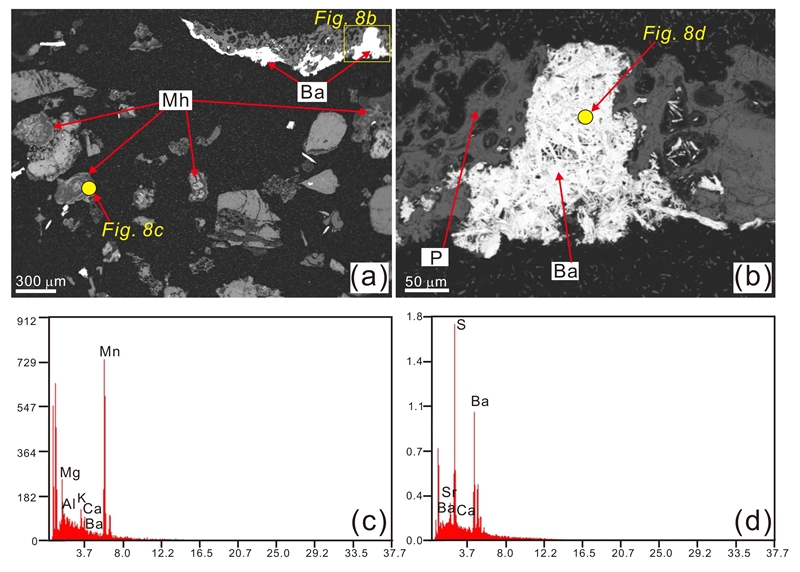
Backscattered electron image (BSEI) and energy dispersive spectrometer (EDS) results of a fine-grained sediment sample from GTV 10 station in the western part of caldera at TA25 submarine volcano. (a) Barite (Ba) and manganese hydroxides (Mh) fragments. (b) Enlarged view of (a) showing crested barite aggregates. EDS results showing (c) manganese hydroxides and (d) barite. P: pumice fragments.
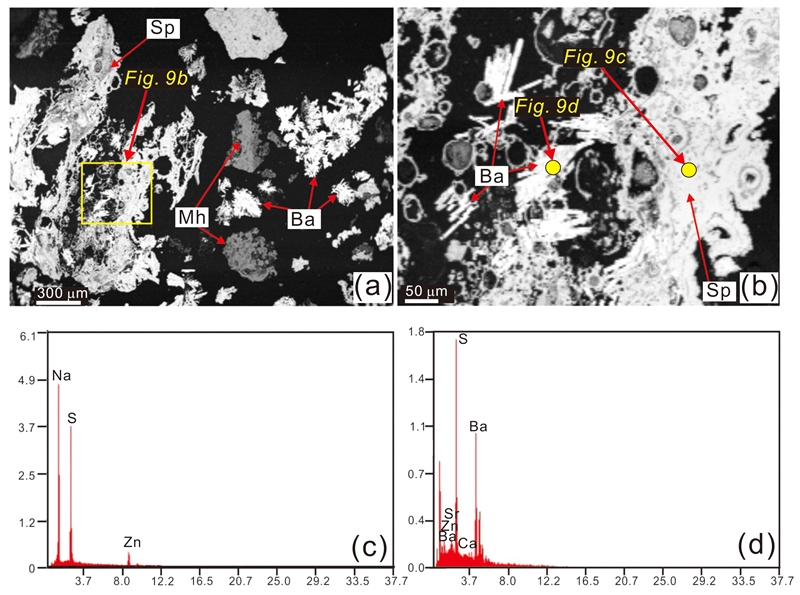
Backscattered electron image (BSEI) and energy dispersive spectrometer (EDS) results of a fine-grained sediment sample from GT110210 station in the eastern part of caldera at TA25 submarine volcano. (a) Barite (Ba) aggregates, manganese hydroxide (Mh) fragments, and sphalerite (Sp) fragments. (b) Enlarged view of (a) showing crested barite and sphalerite fragments. EDS results showing sphalerite (c) and barite (d).

Backscattered electron image (BSEI) and energy dispersive spectrometer (EDS) results of fine-grained sediment samples from GT110211 and GT110213 stations in the eastern part of caldera at TA25 submarine volcano. (a) Colloform pyrite (Py) aggregates with framboidal pyrite (fPy) aggregates (green circles) at GT110211 station sediments. (b) Chalcopyrite (Cp) fragments and barite aggregates at GT110213 station sediments. EDS results showing (c) pyrite and (d) chalcopyrite.
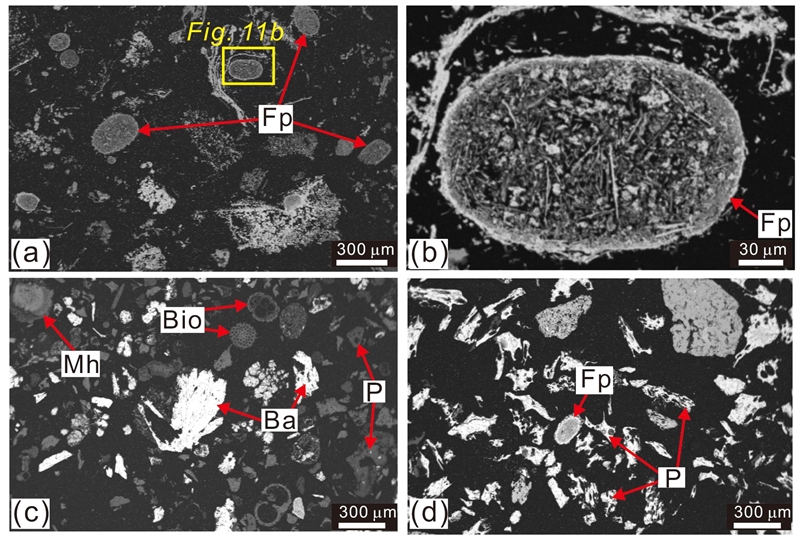
Backscattered electron image (BSEI) of fine-grained sediment samples from GT110206, GT110211, and GT110212 stations in TA25 submarine volcano. (a) Fecal pellet (Fp) from GT110211 station sediments in the eastern caldera. (b) Enlarged view of (a) showing fine-grained aggregates with outer rim. (c) Barite (Ba), manganese hydroxides (Mh) fragments, and biogenic components (Bio) from GT110212 station sediments in the western caldera, (d) Pumice fragments (P) and fecal pellet from GT110206 station sediments in the western caldera.
4. 토 의
4.1 해저퇴적물에서의 열수작용 증거
TA25 해저화산 수심 1,000~1,100 m의 서측 칼데라에서는 화산쇄설성 퇴적층, 재동된 암석편층과 퇴적층을 얇게 피복한 원양성 퇴적물들이 분포한다(그림 3). 이번 연구에서 분석된 부석들은 해저면의 재동된 암석편층에서 채취된 것으로, 낮은 칼륨함량을 갖는 데사이트질 마그마 성분이다(그림 5). 통가-케르마데크 열도 해저화산의 칼데라에서는 용암류(lava flows), 화산쇄설성 퇴적층, 재동된 암석편층 들이 다양하게 분포하는데(Hekinian et al., 2008; Kim et al., 2013), 이들은 전체적으로 낮은 칼륨함량을 갖는 현무암질부터 데사이트질 마그마 성분을 갖는다(그림 5; Smith et al., 2003; Brandl et al., 2020; Myeong et al., 2020). 부석의 외곽부는 두께 1 cm 이내의 암갈색 피복 물질이 덮고 있는데(그림 4), 이들의 망간산화물, 철산화물, 마그네슘산화물 함량은 내부의 유백색 부분에 비하여 각각 최대 약 300배(1.26~43.94 wt%), 약 3.8배(3.92~14.65 wt%), 약 5.3배(1.24~3.80 wt%) 높게 나타난다(그림 6). 암갈색 피복 부분의 Ba, Rb, Sr, Pb, Nb, V, Co, Ni, Cu, Zn, Mo 금속원소 함량도 데사이트질 마그마 성분보다 최대 수 백배 높게 나타난다(표 3). 다공질 부석들은 기공이 잘 발달되어 있음에도, 기공을 통한 부석 내부로 금속원소의 이동은 제한적이었음을 알 수 있다. 이것은 부석이 화산쇄설성 퇴적층으로부터 재동되어 해저면에 노출된 이후에 열수로부터 이동된 입자성 Mn, Fe, Ba, Sr, Pb, Cu, Ni, Mo 금속원소들이 흡착된 결과로 해석된다. TA25 해저화산의 열수분출구 근처에 설치된 퇴적물 트랩에서는 해수에 포함된 열수기원의 입자성 망간, 철, 구리, 아연 금속원소들이 확인되었으며(Kim et al., 2016), 열수기원의 입자성 망간의 장거리 이동도 보고되었다(Lee et al., 2021a).
통가열도 해저화산의 열수분출구 근처에서 채취된 세립질 해저퇴적물에서는 열수기원 금속 함량의 부화 현상이 보고되었다(Daesslé et al., 2000; Cho et al., 2012; Um et al., 2013; Kim et al., 2016). 이번 연구에서는 TA25 해저화산 열수분출구 근처에서 채취된 세립질 표층퇴적물에 포함된 열수기원 황산염광물과 황화광물들의 형태와 분포 특성이 밝혀졌다. 열수기원의 황산염광물인 중정석은 용존 Ba과 해수의 황산염이 결합하여 206~257℃ 온도 범위에서 침전되는 것으로 보고되었다(Okubo et al., 2020). 중정석은 TA25 해저화산 동측(GT110210, GT110212 정점)과 서측(GTV10, GT110213 정점) 표층퇴적물에서 관모(crested)형태의 입자 또는 집합체로 나타났으며(그림 8, 9, 10, 11), GTV10 정점에서는 중정석이 부석 입자의 한쪽 면에서만 침전되어 있으며, 중정석이 침전된 면에 인접한 기공에서만 중정석 입자가 나타났다(그림 8a, 8b). 이것은 중정석이 침전된 부석 입자의 한쪽 면이 해수에 노출되어 높은 용존 Ba 함량을 갖는 열수의 영향을 받은 것으로 해석된다. TA25 해저화산에서 활동성 열수분출구에서 측정된 열수 온도는 231℃~263℃ 범위로 중정석 형성 조건에 부합된다(Kim et al., 2016). 열수기원의 용존 Mn, Zn, Ba, Fe들은 열수분출구로부터 3 km 이상 떨어진 해수에서도 부화되어 있는 것이 보고되었다(Daesslé et al., 2000). 이번 조사 정점 중에서 GT110206과 GT110211 정점에서는 중정석이 관찰되지 않았는데, 이곳은 중정석 생성에 필요한 충분한 열수기원 용존 Ba의 공급이 일어나지 않았던 곳으로 해석된다. 비정질 망간수산화물 입자들은 가장자리가 뜯겨져 나간 파편 형태로 나타나는데(그림 8a, 9a, 11c), 열수기원의 용존 Mn에 의해서 망간수산화물이 형성된 이후에 본체로부터 뜯겨져 나가 이동되어 퇴적된 것으로 해석된다. 교질상 황철석 집합체는 GT110211 정점에서만 관찰되었는데, 교질상 황철석 내부에는 포도상 입자의 흔적이 남아있다(그림 10a). 열수기원의 용존 Fe에 의해서 황철석이 일차적으로 침전될 때는 대부분 포도상으로 형성되며, 그 이후 퇴적물 내 매몰된 상태에서 속성작용에 의하여 교질상 또는 반자형으로 변환된다(Liu et al., 2022). GT110211 정점에서 발견된 교질상 황철석은 일차적인 침전 이후에 매몰과정을 거친 후 이차적으로 이동 퇴적된 것으로 해석된다. 그리고 상대적으로 큰 입자인 열수기원 용존 Fe의 경우는 열수분출구 근처에 대부분 부화되어 나타난다(Stensland et al., 2019; Fang and Wang, 2021). 황화광물인 황동석 입자는 GT110213 정점에서 채취된 표층퇴적물에서만 관찰되었는데(그림 10b), 황동석의 경우는 고온(약 300℃)의 환경에서 형성되는 것으로 보고되었다(Fan et al., 2021). 황화광물인 섬아연석 입자는 GT110210 정점의 표층퇴적물에서만 관찰되는데(그림 9b), 섬아연석의 가장자리가 뜯겨져 나간 파편 형태로 발견되었으며, 섬아연석 내 빈 공간에 중정석 입자가 침전되어 있다(그림 9b). TA26 해저화산에서 채취된 퇴적물의 X-선 회절분석 결과에서도 중정석, 섬아연석, 황철석이 확인되었다(Cho et al., 2012). TA25 해저화산에서 채취된 표층퇴적물에서도 중정석, 섬아연석, 황철석, 황동석과 망간수산화물이 확인되었으며, 관모 형태의 중정석은 열수기원의 용존 Ba과 해수의 황산염과 반응하여 일차적으로 침전된 것으로 해석된다. 그리고 비정질 망간수산화물, 교질상 황철석, 섬아연석, 황동석들은 입자성 파편 형태로 이동되어 퇴적된 것으로 해석된다.
4.2 열수분출구 주변 해양생태계 지시자
해저면 침니 또는 마운드의 열수가 분출되는 지역에서는 저서생물(갑각류, 연체동물, 다모류)과 미생물의 군집이 보고되었다(Dong et al., 2019). TA25 해저화산의 열수분출구 근처에서도 다양한 저서생물과 미생물 군집이 발견되었으며, 이들 저서생물들은 열수기원 금속원소들이 축적되어 있다고 보고되었다(Lee et al., 2015; Lee et al., 2021b). 열수분출구 근처에 설치된 퇴적물 트랩에서는 망간 함량이 높은 동물성 플랑크톤(zooplankton)의 타원형 배설물이 발견되었는데, 이것을 열수의 영향을 받은 해수에 서식하는 동물성 플랑크톤의 생지화학적 작용으로 형성된 것으로 해석되었다(Tambiev and Demina, 1992). 열수분출구 근처의 해양생태계에 대한 많은 연구에 비하여 저서생물에 의해서 생성된 배설물의 특성은 연구가 거의 이루어지지 않았다(Georgieva et al., 2021). 일반 해양환경에서는 저서생물에 의해서 생성된 배설물 특성은 보고된 적이 있으나(Nott and Nicolaidou, 1996; Ziegler et al., 2020), 통가열도 해저화산에서는 저서생물의 배설물 기록이 보고된 바가 없다. TA25 해저화산의 GT110211 정점에서 채취된 표층퇴적물에서는 100~300 µm 크기의 타원형 배설물들이 다수 관찰되었고(그림 11a), GT110206 정점의 표층퇴적물에서는 한 개의 타원형 배설물이 관찰되었다(그림 11d). TA25 해저화산의 나머지 조사 정점들에서는 배설물이 관찰되지 않았다. 이번 연구의 조사 정점들은 열수분출구 주변에 위치하며, 반시계 방향의 저층류가 관측되어 전체적으로 열수의 영향을 받는 곳으로 해석되었다(Kim et al., 2016). 해수에 서식하는 동물성 플랑크톤에 의해서 생성된 배설물이 해저면으로 낙하되어 쌓인 경우에는 모든 조사 정점에서 관찰되어야 하지만, GT110211 정점에서만 다수의 타원형 배설물이 쌓인 것은 이곳이 열수분출구 주변의 저서생물이 활동할 수 있는 곳에 위치하는 것을 지시한다. GT110211 정점 주변에서는 블랙 스모커가 분출되는 활동성 침니가 보고되었으며(Kim et al., 2016), 이 정점의 표층퇴적물에서만 교질성 황철석 집합체가 나타나는 것들이 이를 뒷받침한다.
5. 결 론
남서태평양 통가열도 TA25 해저화산 수심 945~1,093 m에는 다수의 열수분출구가 존재하며, 이곳에는 화산쇄설성 퇴적층, 재동된 암석편층, 세립질 표층퇴적물이 얇게 덮여있다. TA25 해저화산 조사 정점에서는 조립질 부석과 세립질 표층퇴적물들이 채취되었으며, 시료에서는 열수기원의 황화광물, 황산염광물, 금속원소 성분이 분석되었다. 조립질 부석의 외곽부는 1 cm 이내의 암갈색 물질이 피복하고 있는데, 부석의 원래 데사이트질 마그마 성분에 비하여 망간산화물은 최대 약 300배, 철산화물은 약 3.8배 높게 나타났다. 외곽부 암갈색 피복 부분의 Ba, Rb, Sr, Pb, Nb, V, Co, Ni, Cu, Zn, Mo 금속 함량도 데사이트질 마그마 성분에 비하여 높게 나타나는데, Cu 함량의 경우는 최대 약 570배 이상 높게 나타난다. 이것은 열수기원의 입자성 금속원소들이 부석의 외곽부에 흡착된 결과로 해석된다. 세립질 표층퇴적물에서는 열수기원 용존 Ba과 해수의 황산염 결합에 의해서 침전된 관모(crested) 형태의 중정석 입자와 집합체들이 다수 관찰된다. 그리고 망간수산화물, 섬아연석, 황철석, 황동석들은 열수기원 용존 금속의 침전으로 일차적인 생성 이후에 본체로부터 뜯겨져 파편 형태로 이동 퇴적된 것으로 해석된다. 일부 조사 정점에서 관찰되는 타원형의 배설물은 열수분출구 주변에 서식하는 저서생물들에 의해서 형성된 것으로 해석된다.
Acknowledgments
본 연구는 한국지질자원연구원에서 수행한 “국토 지질조사 및 지질도∙지질주제도(22-3111-2)” 사업의 지원으로 수행되었다. TA25 해저화산에서 획득된 해저퇴적물 시료는 “해저열수광상 해저퇴적물 및 기반암의 열수변질대 연구” 사업에서 제공된 것이다. 해저퇴적물 시료 채취에 필요한 연구비 지원 기관인 한국해양과학기술원과 R/V Zonne 승선과 학자에게 감사드린다. 이 논문에 좋은 의견을 주신 심사위원들께 감사드린다.
References
-
Brandl, P.A., Schmid, F., Augustin, N., Grevemeyer, I., Arculus, R.J., Devey, C.W., Petersen, S., Stewart, M., Kopp, H. and Hannington, M.D., 2020, The 6-8 Aug 2019 eruption of ‘Volcano F’ in the Tofua arc, Tonga. Journal of Volcanology and Geothermal Research, 390, 106695.
[https://doi.org/10.1016/j.jvolgeores.2019.106695]

-
Brenna, M., Cronin, S.J., Smith, I.E.M., Pontesilli, A., Tost, M., Barker, S., Tonga’onevai, S., Kula, T. and Vaiomounga, R., 2022, Post-caldera volcanism reveals shallow priming of an intra-ocean arc andesitic caldera: Hunga volcano, Tonga, SW Pacific. Lithos, 412-413, 106614.
[https://doi.org/10.1016/j.lithos.2022.106614]

-
Chavagnac, V., Ali, H.S., Jeandel, C., Leleu, T., Destrigneville, C., Castillo, A., Cotte, L., Waeles, M., Cathalot, C., Laes-Huon, A., Pelleter, E., Nonnotte, P., Sarradin, P.-M. and Cannat, M., 2018, Sulfate minerals control dissolved rare earth element flux and Nd isotope signature of buoyant hydrothermal plume (EMSO-Azores, 37°N Mid-Atlantic Ridge). Chemical Geology, 499, 111-125.
[https://doi.org/10.1016/j.chemgeo.2018.09.021]

-
Cho, H.G., Kim, Y.-H., Um, I.K. and Choi, H.S., 2012, Hydrothermal alteration around the TA 26 seamounts of the Tofua volcanic arc in Lau Basin, Tonga. Journal of Mineralogy Society of Korea, 25, 233-247 (in Korean with English abstract).
[https://doi.org/10.9727/jmsk.2012.25.4.233]

- Choi, S.Y., Kim, C.H., Park, C.H. and Kim, H.R., 2018, Characterizing magnetic properties of TA (Tofua arc) 22 seamount (23° 34´ S) in the Lau Basin, southwestern Pacific. Geophysics and Geophysical Exploration, 21, 67-81.
-
Clift, P.D., Rose, E.F., Shimizu, N., Layne, G.D., Draut, A.E. and Reelous, M., 2001, Tracing the evolving flux from the subducting plate in the Tonga-Kermadec arc system using boron in volcanic glass. Geochimica et Cosmochimica Acta, 65, 3347-3364.
[https://doi.org/10.1016/S0016-7037(01)00670-6]

-
Cronan, D.S. and Hodkinson, R.A., 1997, Geochemistry of hydrothermal sediments from ODP Sites 834 and 835 in the Lau Basin, southwest Pacific. Marine Geology, 141, 237-268.
[https://doi.org/10.1016/S0025-3227(97)00071-6]

-
Daesslé, L.W., Cronan, D.S., Marchig, V. and Wiedicke, M., 2000, Hydrothermal sedimentation adjacent to the propagating Valu Fa Ridge, Lau Basin, SW Pacific. Marine Geology, 162, 479-500.
[https://doi.org/10.1016/S0025-3227(99)00065-1]

-
Dong, C., Xie, Y., Li, H., Lai, Q., Liu, X. and Shao, Z., 2019, Faunal and microbial biodiversity of the newly discovered Deyin-1 hydrothermal vent field at 15°S on the southern Mid-Atlantic Ridge. Deep Sea Research Part I: Oceanographic Research Papers, 153, 103134.
[https://doi.org/10.1016/j.dsr.2019.103134]

-
Eom, J., Yoshimura, T., Araoka, D., Gamo, T. and Kawahata, H., 2020, Magnesium isotopic composition of submarine vent fluids from arc and back-arc hydrothermal systems in the western Pacific. Chemical Geology, 551, 119767.
[https://doi.org/10.1016/j.chemgeo.2020.119767]

-
Fan, L., Wang, G., Holzheid, A., Zoheir, B. and Shi, X., 2021, Isocubanite-chalcopyrite inter growths in the Mid-Atlantic Ridge 26°S hydrothermal vent sulfides. Geochemistry, 81, 125795.
[https://doi.org/10.1016/j.chemer.2021.125795]

-
Fang, Z. and Wang, W.-X., 2021, Size speciation of dissolved trace metals in hydrothermal plumes on the Southwest Indian Ridge. Science of the Total Environment, 771, 145367.
[https://doi.org/10.1016/j.scitotenv.2021.145367]

-
Gartman, A., Findlay, A.J., Hannington, M., Garbe-Schönberg, D., Jamieson, J.W. and Kwasnitschka, T., 2019, The role of nanoparticles in mediating element deposition and transport at hydrothermal vents. Geochimica et Cosmochimica Acta, 261, 113-131.
[https://doi.org/10.1016/j.gca.2019.06.045]

-
Georgieva, M.N., Little, C.T.S., Maslennikov, V.V., Glover, A.G., Ayupova, N.R. and Herrington, R.J., 2021, The history of life at hydrothermal vents. Earth-Science Reviews, 217, 103602.
[https://doi.org/10.1016/j.earscirev.2021.103602]

-
Hekinian, R., Mühe, R., Worthington, T.J. and Stoffers, P., 2008, Geology of a submarine volcanic caldera in the Tonga arc: Dive results. Journal of Volcanology and Geothermal Research, 176, 571-582.
[https://doi.org/10.1016/j.jvolgeores.2008.05.007]

-
Hung, J.-J., Yeh, H.-Y., Peng, S.-H. and Chen, C.T.A., 2018, Influence of submarine hydrothermalism on sulfur and metal accumulation in surface sediments in the Kueishantao venting field off northeastern Taiwan. Marine Chemistry, 198, 88-96.
[https://doi.org/10.1016/j.marchem.2017.12.004]

-
Keith, M., Haase, K.M., Häckel, F., Schwarz-Schampera, U., Klemd, R., Hannington, M., Strauss, H., McConachy, T. and Anderson, M., 2021, Trace element fractionation and precipitation in submarine back-arc hydrothermal systems, Nifonea caldera, New Hebrides subduction zone. Ore Geology Reviews, 135, 104211.
[https://doi.org/10.1016/j.oregeorev.2021.104211]

-
Kim, H.-J., Jou, H.-T., Lee, G.-H., Na, J.-H., Kim, H.-S., Jang, U., Lee, K.-Y., Kim, C.-H., Lee, S.H., Park, C.-H., Jung, S.-K. and Suk, B.-C., 2013, Caldera structure of submarine volcano #1 on the Tonga Arc at 21°09´S, southwestern Pacific: Analysis of multichannel seismic profiling. Earth Planets Space, 65, 893-900.
[https://doi.org/10.5047/eps.2013.01.002]

-
Kim, H.J., Kim, J., Pak, S.J., Ju, S.-J., Yoo, C.M., Kim, H.S., Lee, K.Y. and Hwang, J., 2016, Geochemical characteristics of sinking particles in the Tonga arc hydrothermal vent field, southwestern Pacific. Deep-Sea Research I, 116, 118-126.
[https://doi.org/10.1016/j.dsr.2016.07.015]

- Korea Ocean Research and Development Institute (KORDI), 2012, Cruise report on SMST2012. KORDI, 210 p (in Korean).
-
Lee, J.-M., Lam, P.J., Vivancos, S.M., Pavia, F.J., Anderson, R.F., Lu, Y., Cheng, H., Zhang, P., Edwards, R.L., Xiang, Y. and Webb, S.M., 2021a, Changing chemistry of particulate manganese in the near- and far-field hydrothermal plumes from 15°S East Pacific Rise and its influence on metal scavenging. Geochimica et Cosmochimica Acta, 300, 95-118.
[https://doi.org/10.1016/j.gca.2021.02.020]

-
Lee, S., Kim, S.-J., Ju, S.-J., Pak, S.-J., Son, S.-K., Yang, J. and Han, S., 2015, Mercury accumulation in hydrothermal vent mollusks from the southern Tonga arc, southwestern Pacific Ocean. Chemosphere, 127, 246-253.
[https://doi.org/10.1016/j.chemosphere.2015.01.006]

-
Lee, W.-K., Juniper, S.K., Perez, M., Ju, S.-J. and Kim, S.-J., 2021b, Diversity and characterization of bacterial communities of five co-occurring species at a hydrothermal vent on the Tonga Arc. Ecology and Evolution, 11, 4481-4493.
[https://doi.org/10.1002/ece3.7343]

-
Liu, K., Huang, F., Gao, S., Zhang, Z., Ren, Y. and An, B., 2022, Morphology of framboidal pyrite and its textural evolution: Evidence from the Logatchev area, Mid-Atlantic Ridge. Ore Geology Reviews, 141, 104630.
[https://doi.org/10.1016/j.oregeorev.2021.104630]

-
Menini, E. and Dover, C.L.V., 2019, An atlas of protected hydrothermal vents. Marine Policy, 108, 103654.
[https://doi.org/10.1016/j.marpol.2019.103654]

-
Myeong, B., Kim, J., Kim, J.H. and Jang, Y.D., 2020, Petrogenesis of subduction-related lavas from the southern Tonga arc. Journal of Asian Earth Sciences, 188, 104089.
[https://doi.org/10.1016/j.jseaes.2019.104089]

-
Nott, J.A. and Nicolaidou, A., 1996, Kinetics of metals in molluscan faecal pellets and mineralized granules, incubated in marine sediments. Journal of Experimental Marine Biology and Ecology, 197, 203-218.
[https://doi.org/10.1016/0022-0981(95)00155-7]

-
Okubo, J., Klyukin, Y.I., Warren, L.V., Sublett Jr., D.M., Bodnar, R.J., Gill, B.C. and Xiao, S., 2020, Hydrothermal influence on barite precipitates in the basal Ediacaran Sete Lagoas cap dolostone, São Francisco Craton, central Brazil. Precambrian Research, 340, 105628.
[https://doi.org/10.1016/j.precamres.2020.105628]

-
Omosanya, K.O., Eruteya, O.E., Siregar, E.S.A., Zieba, K.J., Johansen, S.E., Alves, T.M. and Waldmann, N.D., 2018, Three-dimensional (3-D) seismic imaging of conduits and radial faults associated with hydrothermal vent complexes (Vøring Basin, Offshore Norway). Marine Geology, 399, 115-134.
[https://doi.org/10.1016/j.margeo.2018.02.007]

-
Park, J.-W., Campbell, I.H., Kim, J. and Moon, J.-W., 2015, The role of late sulfide saturation in the formation of a Cu- and Au-rich magma: Insights from the platinum group element geochemistry of Niuatahi-Motutahi lavas, Tonga rear arc. Journal of Petrology, 56, 59-81.
[https://doi.org/10.1093/petrology/egu071]

-
Paropkari, A.L., Ray, D., Balaram, V., Prakash, L.S., Mirza, I.H., Satyanarayana, M., Rao, T.G. and Kaisary, S., 2010, Formation of hydrothermal deposits at Kings Triple Junction, northern Lau back-arc basin, SW Pacific: The geochemical perspectives. Journal of Asian Earth Sciences, 38, 121-130.
[https://doi.org/10.1016/j.jseaes.2009.12.003]

-
Smith, I.E.M. and Price, R.C., 2006, The Togan-Kermadec arc and Havre-Lau back-arc system: Their role in the development of tectonic and magmatic models for the western Pacific. Journal of Volcanology and Geothermal Research, 156, 315-331.
[https://doi.org/10.1016/j.jvolgeores.2006.03.006]

-
Smith, I.E.M., Stewart, R.B. and Price, R.C., 2003, The petrology of a large intra-oceanic silicic eruption: the Sandy Bay Tephra, Kermadec Arc, Southwest Pacific. Journal of Volcanology and Geothermal Research, 124, 173-194.
[https://doi.org/10.1016/S0377-0273(03)00040-4]

-
Stensland, A., Baumberger, T., Lilley, M.D., Okland, I.E., Dundas, S.H., Roerdink, D.L., Thorseth, I.H. and Pedersen, R.B., 2019, Transport of carbon dioxide and heavy metals from hydrothermal vent to shallow water by hydrate-coated gas bubbles. Chemical Geology, 513, 120-132.
[https://doi.org/10.1016/j.chemgeo.2018.12.021]

-
Tambiev, S.B. and Demina, L.L., 1992, Biogeochemistry and fluxes of manganese and some other metals in regions of hydrothermal activities (Axial Mountain, Juan de Fuca Ridge and Guaymas Basin, Gulf of California). Deep-Sea Research, 39, 687-703.
[https://doi.org/10.1016/0198-0149(92)90095-B]

-
Um, I.K., Chun, J.-H., Choi, H. and Choi, M.S., 2013, Chemical characteristics for hydrothermal alteration of surface sediments from submarine volcanoes of the Tonga Arc. Journal of the Mineralogical Society of Korea, 26, 245-262 (in Korean with English abstract).
[https://doi.org/10.9727/jmsk.2013.26.4.245]

-
Wan, Y., Wang, X., Chou, I.-M. and Li, X., 2021, Role of sulfate in the transport and enrichment of REE in hydrothermal systems. Earth and Planetary Science Letters, 569, 117068.
[https://doi.org/10.1016/j.epsl.2021.117068]

-
Watanabe, H.K., Shigeno, S., Fujikura, K., Matsui, T., Kato, S. and Yamamoto, H., 2019, Faunal composition of deep-sea hydrothermal vent fields on the Izu-Bonin-Mariana Arc, northwestern Pacific. Deep-Sea Research I: Oceangraphic Research Papers, 149, 103050.
[https://doi.org/10.1016/j.dsr.2019.05.010]

-
Wilckens, F.K., Reeves, E.P., Bach, W., Meixner, A., Seewald, J.S., Koschinsky, A. and Kasemann, S.A., 2018, The influence of magmatic fluids and phase separation on B systematics in submarine hydrothermal vent fluids from back-arc basins. Geochimica et Cosmochimica Acta, 232, 140-162.
[https://doi.org/10.1016/j.gca.2018.04.023]

-
Worthington, T.J., Gregory, M.R. and Bondarenko, V., 1999, The Denham caldera on Raoul volcano: dacitic volcanism in the Tonga-Kermadec arc. Journal of Volcanology and Geothermal Research, 90, 29-48.
[https://doi.org/10.1016/S0377-0273(99)00018-9]

-
Ziegler, A.F., Cape, M., Lundesgaard, Ø. and Smith, C.R., 2020, Intense deposition and rapid processing of seafloor phytodetritus in a glaciomarine fjord, Andvord Bay (Antarctica). Progress in Oceanography, 187, 102413.
[https://doi.org/10.1016/j.pocean.2020.102413]


